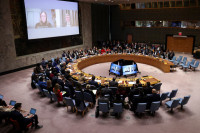Opinion
Among the audience
Audiences always have the liberty to interpret, retrieve, and reuse a piece of art whenever needed
Deepesh Paudel
Whenever I come up with a theatrical venture, I believe my art has to travel a lot. In fact, I expect and want it to travel a lot. I want it to reach the group of people sitting in the audience that receives and perceives my manifestations. Meanwhile, I also realise that these perceptions will differ due to people’s diversity in terms of knowledge, interests, thought processes, culture, and social upbringing. They will have their own ways of interpreting art. So, does this possible discrepancy bother me? Or do I want my entire audience to perceive my creation in the particular manner of my choice?
All artists would love to have their works appreciated and accepted. This appreciation, however, can come in different forms. The criteria to gauge an art’s success or effectiveness can depend upon tangibles, intangibles or both. For instance, the success of a Bollywood movie could be reflectled through box office collections, like Rohit Shetty’s money-spinning blockbusters, or by its longevity, like most of Raj Kumar Hirani’s films. However, on a larger scale, ‘pure’ artists usually prefer to have their creations appreciated artistically, more than financially. Therefore, in order to make art that is welcomed and well-received by the audience, one needs to understand the audience’s expectations.
Analysing the audience
To study and comprehend a human mind is next to impossible. On a general psychological note, the depth of complexities and the width of unorganised expectations or desires present in a human mind make it extremely difficult to understand it. Under such conditions, service providers often look for a strategy to cater to the wants of collective homogenous groups. For instance, in the marketing domain, marketers often use approaches such as profiling, segmenting, and targeting to identify their core audience. These help them match their product or service with the customer’s requirements. Furthermore, this provides a foundation for customisation or personalisation in services. Hence, if we consider theatre as an exponentially growing service industry, we need to study and analyse our audience.
As theatre artists, should we consider the audience factor during the pre-creation phase of an artistic production? In reference to the issue in hand, my interaction with Ashesh Malla, a theatre pioneer in Nepal, gave me some insight. Artists, in the process of making art, should never think about the audience, consequences, or potential impacts that their art can make in the future. Rather, they must be focussed on the artistry while expressing the matter of their choice. And, as artists, the only option for them is to hope that their creation relates to wider audiences. People’s preference, social revolts, and cultural transformations are futuristic possibilities for artists and their creations.
Ramesh-Rayan’s famous patriotic song, ‘Gaun gaun bata utha, basti basti batha utha’ has a similar connection. Perhaps no one had ever imagined that a song from a movie, starring iconic comedians like Madan Krishna Shrestha and Haribansha Acharya, would later turn into an anthem for almost all political and revolutionary movements. This shows that the audience always has the liberty to interpret, retrieve, and reuse a piece of art whenever needed, and in whatever way they want.
Artist-audience gap
A couple of years ago, we staged a play called Raktabij at Sarwanam Theatre. Written and directed by Ashesh Malla, the play was rich and powerful in terms of its content. The play portrayed a tyrant’s love for autocracy and superiority. The dialogues of the play metaphorically compared historical and religious tyrants like Hitler, Hirannakasipu, and Kansha with modern-day Nepali rulers. By doing so, it reflected on the dire and helpless circumstances that citizens face due to a ruler’s desire for absolute power. In a nutshell, this piece of art was abundantly relevant and meaningful to varied Nepali audiences. However, much to my surprise, the play was not received well. More surprisingly, it had nothing to do with the acting or presentation aspect of the play, as most of the audience labeled the play as ‘intellectual’; some of them did not even try to contemplate the play’s content and termed it ‘difficult-to-understand’.
This made me realise that there is an existing gap between theatre’s subject-standard and the audience’s understanding-standard. This two-year-old incident still holds true. To address such discrepancies between the provider and the receiver, theatre artists have two alternatives. The first option is to dumb down the content, verbal communication, and mode of presentation so that it can easily reach a wide group. This may, however, lower the quality and artistic potential of the performance by a great extent. In contrast, the other option allows artists to take risks and push the envelope further by creating art that is richer and deeper in terms of subject matter. This will definitely demand a considerable amount of effort by the audience while interpreting and thus, will put an end to the practice of spoon-feeding the audience which is prevalent in Nepali theatre.
Paudel is associated with Sarwanam Theatre as a theatre artist and director ([email protected])




 9.12°C Kathmandu
9.12°C Kathmandu












